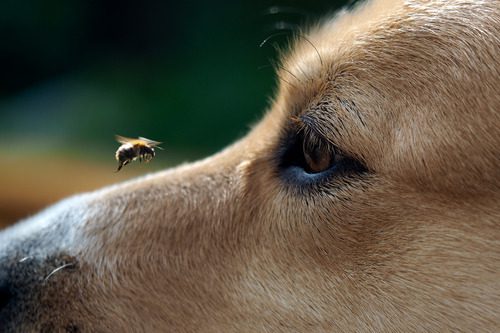My Dog Was Stung by a Bee – What Should I Do?

When a leisurely day outdoors turns worrisome with your dog being stung by a bee, knowing the right steps to take is essential. For many dogs, a bee sting can be a minor irritation, but for others, it could lead to serious complications. In this blog, we’ll guide you through the appropriate actions to take if your dog encounters a bee sting. For detailed advice and immediate care, please contact Stevenson Ranch Veterinary Center at (661) 799-0655 or book an appointment online.
Recognizing a Bee Sting in Dogs
Dogs are curious by nature, which can sometimes lead them into trouble, such as getting too close to a bee. Recognizing a bee sting right away can significantly help in managing your dog’s discomfort. Typically, signs include sudden yelping, pawing at the face or bitten area, swelling, and redness. In some cases, the stinger may still be visible in the skin.
When to Seek Immediate Veterinary Care
While swelling and redness can be common reactions, severe symptoms like excessive drooling, difficulty breathing, or extensive swelling can indicate an allergic reaction. If your dog exhibits any of these signs, it’s critical to seek veterinary care immediately to prevent further complications.
Immediate Actions Post-Sting
After confirming your dog was stung by a bee, keep your pet calm and try to remove the stinger if it’s visible. It’s best done using a flat-edged object like a credit card to gently scrape it out. Avoid using tweezers as squeezing could release more venom into the skin.
Monitoring Your Dog
Post-sting, it’s crucial to closely monitor your dog for any changes in behavior or worsening symptoms. Keep them cool and quiet as activity can increase venom circulation. If symptoms progress or don’t improve within a few hours, contact your vet at Stevenson Ranch Veterinary Center.
The Importance of Veterinary Consultation
Even if the initial sting seems mild, consulting with a veterinarian is advisable. They can provide appropriate medications to reduce pain and swelling, and ensure there are no further risks to your dog’s health. Veterinarians can administer treatments such as antihistamines or steroids to manage the reaction effectively. Remember, a quick response can make all the difference. They also offer guidance on how to prevent future incidents and what to watch for if your dog encounters a bee again.
Preventing Bee Stings
While it’s not always possible to avoid an encounter with a bee, you can take steps to minimize the risks. Keep your dog away from known bee habitats like flower gardens or orchards during peak activity times. Training your dog to come when called can also swiftly remove them from a risky situation.
Safe Outdoor Practices
When outside, especially in areas with high bee activity, keep your dog on a leash and closely monitor their environment. Avoid using scented products on your dog that could attract bees, such as certain shampoos or perfumes.
Ensuring Your Pet’s Health and Safety
A bee sting can be a distressing event for both you and your pet. By recognizing the signs early and knowing the immediate steps to take, you can ensure your dog receives the right care swiftly. Always consult Stevenson Ranch Veterinary Center for professional advice and treatment following a bee sting. For any concerns or to book an appointment, please call us at (661) 799-0655 or book an appointment online. Together, we can keep your pet safe and healthy through all their outdoor adventures.
Check Your Pet's Records
Look no further, PetDesk allows you to view your Pet's Health information, appointment reminders, etc.
Let's Go Shopping
Need a refill on vitamins, food, etc for your pet? Check our our online store.
Book an Appointment
Looking for Veterinary Care? Stevenson Ranch is a place that you can your pet can depend on for exceptional care.
